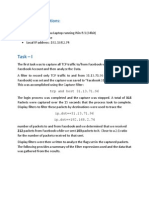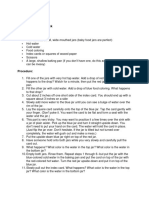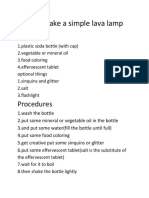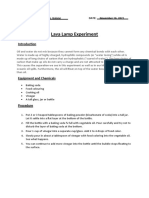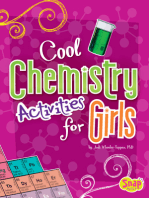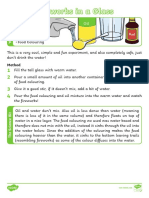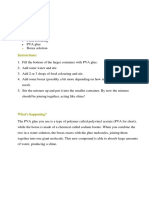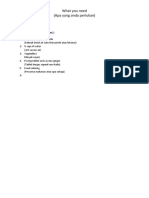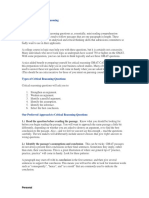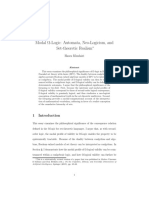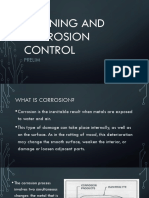0 ratings0% found this document useful (0 votes)
115 viewsBlobs in A Bottle
Blobs in A Bottle
Uploaded by
Jasper Panal Parena1. The document provides instructions for creating a homemade lava lamp using a bottle, water, vegetable oil, food coloring, and fizzing tablets.
2. Oil is poured into a bottle with water and the two separate due to oil's lower density, with oil floating above the water. Food coloring added to the water sinks below the oil.
3. When a fizzing tablet is added, it dissolves in the water and produces carbon dioxide bubbles, causing colored water droplets to rise and fall in a "lava lamp" effect.
Copyright:
© All Rights Reserved
Available Formats
Download as DOCX, PDF, TXT or read online from Scribd
Blobs in A Bottle
Blobs in A Bottle
Uploaded by
Jasper Panal Parena0 ratings0% found this document useful (0 votes)
115 views1 page1. The document provides instructions for creating a homemade lava lamp using a bottle, water, vegetable oil, food coloring, and fizzing tablets.
2. Oil is poured into a bottle with water and the two separate due to oil's lower density, with oil floating above the water. Food coloring added to the water sinks below the oil.
3. When a fizzing tablet is added, it dissolves in the water and produces carbon dioxide bubbles, causing colored water droplets to rise and fall in a "lava lamp" effect.
Original Description:
An amazing thing to try.
Original Title
Blobs in a Bottle
Copyright
© © All Rights Reserved
Available Formats
DOCX, PDF, TXT or read online from Scribd
Share this document
Did you find this document useful?
Is this content inappropriate?
1. The document provides instructions for creating a homemade lava lamp using a bottle, water, vegetable oil, food coloring, and fizzing tablets.
2. Oil is poured into a bottle with water and the two separate due to oil's lower density, with oil floating above the water. Food coloring added to the water sinks below the oil.
3. When a fizzing tablet is added, it dissolves in the water and produces carbon dioxide bubbles, causing colored water droplets to rise and fall in a "lava lamp" effect.
Copyright:
© All Rights Reserved
Available Formats
Download as DOCX, PDF, TXT or read online from Scribd
Download as docx, pdf, or txt
0 ratings0% found this document useful (0 votes)
115 views1 pageBlobs in A Bottle
Blobs in A Bottle
Uploaded by
Jasper Panal Parena1. The document provides instructions for creating a homemade lava lamp using a bottle, water, vegetable oil, food coloring, and fizzing tablets.
2. Oil is poured into a bottle with water and the two separate due to oil's lower density, with oil floating above the water. Food coloring added to the water sinks below the oil.
3. When a fizzing tablet is added, it dissolves in the water and produces carbon dioxide bubbles, causing colored water droplets to rise and fall in a "lava lamp" effect.
Copyright:
© All Rights Reserved
Available Formats
Download as DOCX, PDF, TXT or read online from Scribd
Download as docx, pdf, or txt
You are on page 1of 1
You will need
• A clean, 1-liter clear soda bottle or a plain straight transparent glass
• 3/4 cup of water
• Vegetable Oil or Baby oil
• Fizzing tablets or Aspirin (acetylsalicylic acid)
DENSITY
• Food coloring the degree of compactness of a substance.
a measurement that compares the amount of
matter an object has to its volume. An object with
What to do much matter in a certain volume has high density
1. Pour the water into the bottle.
2. Use a measuring cup or funnel to slowly pour the vegetable oil into the bottle until it’s almost full. You may have to wait a
few minutes for the oil and water separate.
Explanation. Oil molecules are attracted to other oil molecules so they stick together. The same goes
for water molecules so they just don't mix – they are immiscible. Secondly, the oil always floats on top of the water because
the oil has a lower density than water.
3. Add 10 drops of food coloring to the bottle (we like red, but any color will look great.) The drops will pass through the oil
and then mix with the water below.
Explanation. The molecules of water can't mix with the molecules of oil. Even if you try to shake up a bottle of half-
oil and half-water, the oil just breaks up into smaller droplets, but it doesn't truly mix with the water. Also, food coloring only
mixes with water. It does not color the oil at all.
4. Break a seltzer tablet in half and drop the half tablet into the bottle. Watch it sink to the bottom and let the blobby
greatness begin!
Explanation. When you pour the water into the bottle with the oil, the water sinks to the bottom and the oil floats
to the top. ... Water is denser than the oil. The Aspirin tablet reacts with the water to make carbon dioxide gas. These
bubbles attach themselves to the colored water and cause them to float
to the surface. ASPIRIN is used to reduce fever and relieve mild to
moderate pain from conditions such as muscle
5. To keep the effect going, just add another tablet piece. For a true aches, toothaches, common cold, and headaches.
lava lamp effect, shine a flashlight through the bottom of the bottle. It may also be used to reduce pain and swelling in
conditions such as arthritis. C9H8O4
How does it work?
To begin, the oil stays above the water because the oil is lighter than the water or, more specifically, less dense
than water. The oil and water do not mix because of something called “intermolecular polarity.” Molecular polarity basically
means that water molecules are attracted to other water molecules. They get along fine and can loosely bond together
(drops.) This is similar to magnets that are attracted to each other. Oil molecules are attracted to other oil molecules, they
get along fine as well. But the structures of the two molecules do not allow them to bond together. Of course, there’s a lot
fancier scientific language to describe density and molecular polarity, but maybe now you’ll at least look at that example in a
whole new way.
A solution of oil and water is a great example of a heterogeneous mixture. Most of the oils and water are
immiscible - that means they don't mix. Therefore, forming layers between them. A homogeneous mixture is a mixture of
two substances that is completely even throughout the solution and there are no borders in between substances. It looks like
one new substance. In this experiment, different solutions are made by mixing water with different colors and amounts
of food coloring. Students should notice that once the water and colors are mixed together, the liquid looks the same
throughout. It is a solution—a homogeneous mixture.
When you added the tablet piece, it sank to the bottom and started dissolving and creating a gas. As the gas
bubbles rose, they took some of the colored water with them. When the blob of water reached the top, the gas escaped
and down went the water. Cool, huh?
You might also like
- Writing Wireshark Filter Expressions For Packet CaptureDocument9 pagesWriting Wireshark Filter Expressions For Packet CaptureRafay0% (1)
- Lava Lamp ExperimentDocument7 pagesLava Lamp ExperimentLyan EmmyNo ratings yet
- g75 Fanuc Canned Cycle Grooving CNC ProgramDocument2 pagesg75 Fanuc Canned Cycle Grooving CNC ProgramHarshal DhawasNo ratings yet
- LEAPFROG 4.1 Manual - Basico-Intermedio - EnglishDocument133 pagesLEAPFROG 4.1 Manual - Basico-Intermedio - EnglishMelvin Edixon Salazar VásquezNo ratings yet
- DIY Liquid Castile SoapDocument2 pagesDIY Liquid Castile SoapRobert Miles100% (1)
- Density The Amazing Water Trick MaterialsDocument8 pagesDensity The Amazing Water Trick MaterialsTwinkleAnneGonzalesRosalesNo ratings yet
- Blobs BottleDocument3 pagesBlobs BottleTara Anne YuNo ratings yet
- Lava LampDocument3 pagesLava LampTeacher EdnaNo ratings yet
- Lava Lamp 4Document2 pagesLava Lamp 4Nurshida AyuNo ratings yet
- The Best Homemade Lava LampDocument7 pagesThe Best Homemade Lava LampJelena MitrovicNo ratings yet
- How To Make A Simple Lava LampDocument4 pagesHow To Make A Simple Lava LampakosiprixNo ratings yet
- The Lava LampDocument5 pagesThe Lava LampMathew DegamoNo ratings yet
- Science ExperimentsDocument23 pagesScience ExperimentsComeTogetherKids100% (1)
- CHE1400 - Lab5 DescriptionDocument2 pagesCHE1400 - Lab5 Descriptionibtihalboujeddaine176No ratings yet
- ExperimentDocument4 pagesExperimentsasic9697No ratings yet
- EXPERIMENT 1 - WaterDocument13 pagesEXPERIMENT 1 - WaterJade PaquingNo ratings yet
- Lava LampDocument2 pagesLava LampJulia Geonzon LabajoNo ratings yet
- Science IV 2011-2012Document9 pagesScience IV 2011-2012Marc SealzaNo ratings yet
- Enjoy Our Range of Fun Science Experiments For Kids That Feature Awesome HandsDocument4 pagesEnjoy Our Range of Fun Science Experiments For Kids That Feature Awesome HandsRosa ElenaNo ratings yet
- Scienceactivities1 PDFDocument98 pagesScienceactivities1 PDFbbaalluuNo ratings yet
- Investigatory Project SampleDocument6 pagesInvestigatory Project SampleMarian OclinariaNo ratings yet
- Gen Chem PTDocument4 pagesGen Chem PTJR RencioNo ratings yet
- Lava Lamp Experiment: NAME: Trisha Joanne S. Galang DATE: November 16, 2021Document2 pagesLava Lamp Experiment: NAME: Trisha Joanne S. Galang DATE: November 16, 2021Cyrus De LeonNo ratings yet
- LAB 2-CHM01aLDocument5 pagesLAB 2-CHM01aLNova Jane EdradNo ratings yet
- Cool Chemistry Activities for GirlsFrom EverandCool Chemistry Activities for GirlsRating: 5 out of 5 stars5/5 (2)
- Blank Landscape 5Document1 pageBlank Landscape 5api-33562418No ratings yet
- Make A Big Dry Ice Bubble: What You'll NeedDocument9 pagesMake A Big Dry Ice Bubble: What You'll Needฮันนี่ คริสNo ratings yet
- Self Inflating Balloon: Plastic Chemistry - Making SlimeDocument4 pagesSelf Inflating Balloon: Plastic Chemistry - Making SlimeJohn Christian MacanNo ratings yet
- Catch A RainbowDocument6 pagesCatch A Rainbowbech1No ratings yet
- Scientific Experiments for Kids! Chemistry for Kids Series - Children's Analytic Chemistry BooksFrom EverandScientific Experiments for Kids! Chemistry for Kids Series - Children's Analytic Chemistry BooksNo ratings yet
- Fizzy EyeDocument10 pagesFizzy EyeEko Sulistiyaning WarniNo ratings yet
- Laboratory ExperimentDocument5 pagesLaboratory ExperimentKoji OdoNo ratings yet
- Oil and Water: What You'll NeedDocument2 pagesOil and Water: What You'll NeedMelisa MelsNo ratings yet
- Chemistry ScriptDocument16 pagesChemistry ScriptJim Boy BumalinNo ratings yet
- Things NeededDocument13 pagesThings NeededInthara ArthiNo ratings yet
- Science Club - DensityDocument2 pagesScience Club - Densityermie.s.motikNo ratings yet
- Unit DDocument18 pagesUnit DVenkateswara Rao DoodalaNo ratings yet
- Lava LampDocument2 pagesLava LampHema Jothy0% (2)
- Triptico Lampara de LavaDocument7 pagesTriptico Lampara de LavaLuis MachadoNo ratings yet
- SyenSaya 2011 Chemistry DemonstrationsDocument6 pagesSyenSaya 2011 Chemistry DemonstrationsAubrey Malasa FabroNo ratings yet
- 25 Science IdeasDocument5 pages25 Science Ideasapi-334590552No ratings yet
- Lava LampDocument8 pagesLava LampPhatcharakan ChoungsomNo ratings yet
- 2011 EverydayScienceAnswersDocument6 pages2011 EverydayScienceAnswersRajiv KumarNo ratings yet
- Expi 1Document4 pagesExpi 1colinarescharmainefaithNo ratings yet
- Lava Lamp LabDocument6 pagesLava Lamp Labapi-302399796No ratings yet
- Magnetic Pick Up: You Will NeedDocument6 pagesMagnetic Pick Up: You Will NeedLilian Laurel CariquitanNo ratings yet
- What Makes A Ship To FloatDocument40 pagesWhat Makes A Ship To FloatAndre MantovaNo ratings yet
- Make An Easy Lava LampDocument2 pagesMake An Easy Lava LampAnisaNuraidaNo ratings yet
- Make An Easy Lava Lamp: What You'll NeedDocument2 pagesMake An Easy Lava Lamp: What You'll NeedAnisaNuraidaNo ratings yet
- Fireworks in A Glass PDFDocument1 pageFireworks in A Glass PDFAlisa PawNo ratings yet
- Basic HerbalismDocument7 pagesBasic Herbalismfranklloyd1975No ratings yet
- How To Make Lamp Lava: Tool and MaterialDocument1 pageHow To Make Lamp Lava: Tool and Materialkarlita_pamelaNo ratings yet
- Liquid Density RainbowDocument2 pagesLiquid Density RainbowPowerhouse Museum100% (1)
- Charles' Law Rising Water Experiment: Mystery 2Document2 pagesCharles' Law Rising Water Experiment: Mystery 2Zero 22No ratings yet
- Experiments InstructionsDocument4 pagesExperiments InstructionsViktoria DyakivNo ratings yet
- Bulan 2 Fun ScienceDocument20 pagesBulan 2 Fun Sciencewakakesiswaanbk3No ratings yet
- I. Evaporative Cooling: Materials NeededDocument7 pagesI. Evaporative Cooling: Materials NeededCiel Geven100% (1)
- Sains ExperimentDocument6 pagesSains ExperimentMuhammad KhairiNo ratings yet
- Water Labs FullDocument4 pagesWater Labs FulljohnosborneNo ratings yet
- Deleon, Cyrus Q. Bsie-1aDocument3 pagesDeleon, Cyrus Q. Bsie-1aCyrus De LeonNo ratings yet
- Grade 6: Unit 2: MixtureDocument43 pagesGrade 6: Unit 2: MixtureEmylie Alvarez LantoriaNo ratings yet
- Self Inflating Balloon Experiment: Learning ActivitiesDocument10 pagesSelf Inflating Balloon Experiment: Learning Activitieshazron pandianganNo ratings yet
- Location: Project: Date:: Bus 3-Phase Fault Line-to-Ground Fault Line-to-Line Fault Line-to-Line-to-GroundDocument2 pagesLocation: Project: Date:: Bus 3-Phase Fault Line-to-Ground Fault Line-to-Line Fault Line-to-Line-to-GroundBhayz SituyaNo ratings yet
- Vehicle Drive CalculationsDocument4 pagesVehicle Drive Calculationsretrospect1000No ratings yet
- IolDocument7 pagesIolAnonymous h0DxuJTNo ratings yet
- Avogadro LawDocument10 pagesAvogadro LawLerr Real RelleNo ratings yet
- List of Mobile Number PrefixesDocument3 pagesList of Mobile Number PrefixesLeaNo ratings yet
- MechatronicsDocument32 pagesMechatronicskr_abhijeet72356587No ratings yet
- كتاب مشروع تخرج لمستشفىDocument153 pagesكتاب مشروع تخرج لمستشفىOlfa NablyNo ratings yet
- JURNAL NailatusengDocument16 pagesJURNAL NailatusengrhasibuanhrdNo ratings yet
- Jurnal Shahnaz Ke UiDocument6 pagesJurnal Shahnaz Ke UiShahnaz Dwi PermataNo ratings yet
- FIN-573 - Lecture 5 - Feb 18 2021Document41 pagesFIN-573 - Lecture 5 - Feb 18 2021Abdul BaigNo ratings yet
- PHP Six Month Industrial Training Report FileDocument39 pagesPHP Six Month Industrial Training Report FileRAVINDER PALNo ratings yet
- GMAT CAT Critical ReasoningDocument67 pagesGMAT CAT Critical ReasoningSuyash DateNo ratings yet
- G3516 DatasheetDocument6 pagesG3516 DatasheetEn FaizulNo ratings yet
- Eindhoven University of Technology: Award Date: 1995Document89 pagesEindhoven University of Technology: Award Date: 1995shuangwenNo ratings yet
- Modal Ω LogicDocument30 pagesModal Ω Logicluispolinomio9No ratings yet
- Conf 2000B FlucomDocument6 pagesConf 2000B FlucomPietro RosataNo ratings yet
- Amte 133 Prelim LessonDocument35 pagesAmte 133 Prelim LessonGrace Candelario ArellanoNo ratings yet
- Adobe Scan Aug 23, 2023Document4 pagesAdobe Scan Aug 23, 2023Jenny 1107No ratings yet
- Gas CycloneDocument25 pagesGas CycloneComfort MaccarthyNo ratings yet
- Assignment 1Document2 pagesAssignment 1mid_cycloneNo ratings yet
- Matecconf Fatigue2018 10014Document8 pagesMatecconf Fatigue2018 10014sarath chand chowdaryNo ratings yet
- 2.to Study The Effect of Concentration On The Rate of Reaction Between SodiumDocument2 pages2.to Study The Effect of Concentration On The Rate of Reaction Between Sodium123arjunk986No ratings yet
- Limits of FunctionsDocument11 pagesLimits of Functionsnormasulasa100% (1)
- Bayenian Networks JensenDocument6 pagesBayenian Networks JensenjivasumanaNo ratings yet
- 2016 Lab Descriptions and Guides For PHYS 1114 and 2206Document45 pages2016 Lab Descriptions and Guides For PHYS 1114 and 2206farhanNo ratings yet
- Shopito Report - Docx222rohanDocument55 pagesShopito Report - Docx222rohanPratyaksha RatnapriyaNo ratings yet
- Chinese BoxesDocument1 pageChinese BoxesJoko WaluyoNo ratings yet
